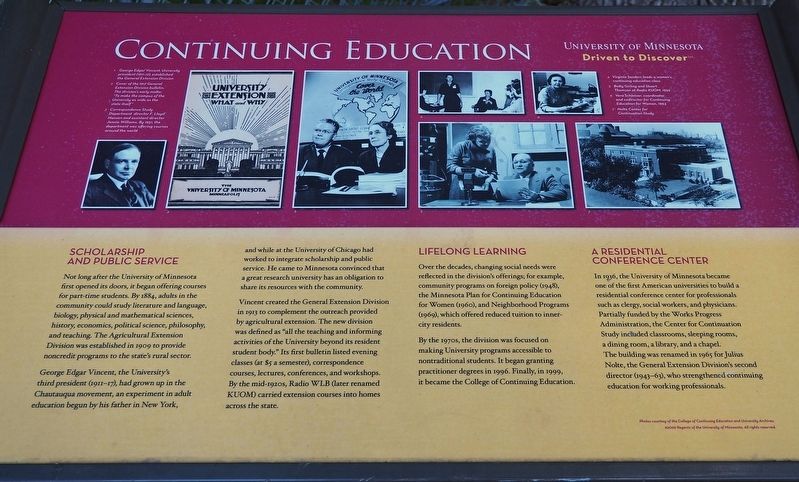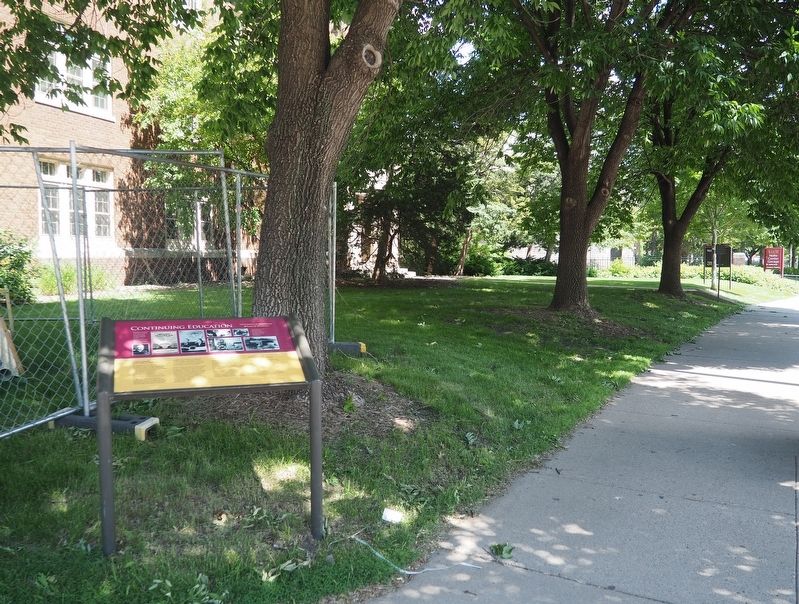University in Minneapolis in Hennepin County, Minnesota — The American Midwest (Upper Plains)
Continuing Education
Driven to Discover
— University of Minnesota —
Scholarship and Public Service
Not long after the University of Minnesota first opened its doors, it began offering courses for part-time students. By 1884, adults in the community could study literature and language, biology, physical and mathematical sciences, history, economics, political science, philosophy, and teaching. The Agricultural Extension Division was established in 1909 to provide noncredit programs to the state's rural sector.
George Edgar Vincent, the University's third president (1911–17), had grown up in the Chautauqua movement, an experiment in adult education begun by his father in New York, and while at the University of Chicago had worked to integrate scholarship and public service. He came to Minnesota convinced that a great research university has an obligation to share its resources with the community.
Vincent created the General Extension Division in 1913 to complement the outreach provided by agricultural extension. The new division was defined as "all the teaching and informing activities of the University beyond its resident student body." Its first bulletin listed evening classes (at $5 a semester), correspondence courses, lectures, conferences, and workshops. By the mid-1920s, Radio WLB (later renamed KUOM) carried extension courses into homes across the state.
Lifelong Learning
Over the decades, changing social needs were reflected in the division's offerings; for example, community programs on foreign policy (1948), the Minnesota Plan for Continuing Education for Women (1960), and Neighborhood Programs (1969), which offered reduced tuition to inner-city residents.
By the 1970s, the division was focused on making University programs accessible to nontraditional students. It began granting practitioner degrees in 1996. Finally, in 1999, it became the College of Continuing Education.
A Residential Conference Center
In 1936, the University of Minnesota became one of the first American universities to build a residential conference center for professionals such as clergy, social workers, and physicians. Partially funded by the Works Progress Administration, the Center for Continuation Study included classrooms, sleeping rooms, a dining room, a library, and a chapel. The building was renamed in 1965 for Julius Nolte, the General Extension Division's second director (1943–63), who strengthened continuing education for working professionals.
[Photo captions]
1. George Edgar Vincent, University president (1911-17), established the General Extension Division
2. Cover of the 1917 General Extension Division bulletin. The division's early motto: "To make the campus of the University as wide as the state itself"
3. Correspondence Study Department director F. Lloyd Hansen and assistant director Jennie Williams. By 1951, the department was offering courses around the world
4. Virginia Senders leads a women's continuing education class
5. Betty Girling and Stuart Thomson at Radio KUOM, 1956
6. Vera Schletzer, coordinator and codirector for Continuing Education for Women, 1963
7. Nolte Center for Continuation Study
Erected 2009 by Regents of the University of Minnesota.
Topics. This historical marker is listed in this topic list: Education. A significant historical year for this entry is 1884.
Location. 44° 58.621′ N, 93° 14.014′ W. Marker is in Minneapolis, Minnesota, in Hennepin County. It is in University. Marker is at the intersection of Church Street SE and Pillsbury Drive SE, on the right when traveling south on Church Street SE. The marker is on the East Bank campus of the University of Minnesota, in front of the Nolte Center. Touch for map. Marker is at or near this postal address: 315 Pillsbury Dr SE, Minneapolis MN 55455, United States of America. Touch for directions.
Other nearby markers. At least 8 other markers are within walking distance of this marker. Spanish-American War Memorial (within shouting distance of this marker); The Armory Building / Military Training at the University (within shouting distance of this marker); University of Minnesota Spanish-American War Memorial (about 300 feet away, measured in a direct line); Campus Design (about 600 feet away); Opening Doors (about 600 feet away); The Liberal Arts (about 700 feet away); Spanning the Sciences (approx. 0.2 miles away); Education (approx. 0.2 miles away). Touch for a list and map of all markers in Minneapolis.
Credits. This page was last revised on April 24, 2024. It was originally submitted on September 26, 2020, by McGhiever of Minneapolis, Minnesota. This page has been viewed 194 times since then and 21 times this year. Photos: 1, 2. submitted on September 26, 2020, by McGhiever of Minneapolis, Minnesota. • Mark Hilton was the editor who published this page.

